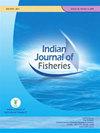食用鱼内脏肠衣的初步筛选及工艺标准化
IF 0.3
4区 农林科学
Q4 FISHERIES
引用次数: 0
摘要
富含蛋白质成分的鱼类内脏可用于制备香肠肠衣,这将成为鱼类加工废物管理的一种手段。对香肠肠衣用鱼内脏的初步筛选、肠衣与羊肠衣的比较以及香肠在-21°C下储存60天的质量分析进行了研究。采集了圆腹蛛(Saurida tumbil)、佩拉米斯蛛(Katsuwonus pelamis)、罗希塔蛛(Labeo rohita)、下眼盘蛛(Pangasius hyphthalmus)和Scomberomorus guttatus的内脏,并对其进行了盐处理以提高质量。按照标准配方,用汤比尔肉制作香肠。鱼香肠在70°C下加工15分钟。通过感官分析,蜥蜴鱼肠被选为香肠肠衣的最佳选择,并通过纹理轮廓分析仪与山羊肠衣进行比较。对pH、过氧化值、游离脂肪酸、总挥发性碱氮、三甲胺和总板数等品质参数进行了分析。随着储存的进行,所有参数都逐渐增加,但在可接受的范围内,pH除外。关键词:替代肠衣、鱼类加工、鱼类香肠、鱼类废物管理本文章由计算机程序翻译,如有差异,请以英文原文为准。
Preliminary screening and process standardisation of edible sausage casing from fish viscera
Fish viscera rich in protein components can be utilised for the preparation of sausage casing which will serve as a means of fish processing waste management. A study was conducted on preliminary screening and selection of fish viscera for sausage casing, comparison of the selected casing with goat casing and quality analysis of the sausage during storage at -21°C for 60 days. Viscera from Saurida tumbil, Katsuwonus pelamis, Labeo rohita, Pangasius hypophthalmus and Scomberomorus guttatus were collected and salt treated to improve quality. A standard recipe was followed for the preparation of sausage using meat of S. tumbil. Fish sausages were processed at 70°C for 15 min. Lizard fish gut was selected as best for sausage casing via sensory analysis and was compared with goat casing by texture profile analyser. There was significant difference in textural qualities except springiness and cohesiveness (p<0.5%). The quality parameters like pH, peroxide value, free fatty acid, total volatile base nitrogen, trimethyl amine and total plate count were analysed. A gradual increase in all parameters was observed as storage proceeded but was within the acceptable limit except pH. Keywords: Alternative casing, Fish processing, Fish sausage, Fish waste management
求助全文
通过发布文献求助,成功后即可免费获取论文全文。
去求助
来源期刊

Indian Journal of Fisheries
FISHERIES-
CiteScore
0.90
自引率
20.00%
发文量
0
审稿时长
6-12 weeks
期刊介绍:
Indian Journal of Fisheries is published quarterly by the Indian Council of Agricultural Research (ICAR), New Delhi. Original contributions in the field of Fish and fisheries science are considered for publication in the Journal. The material submitted must be unpublished and not under consideration for publication elsewhere.
Papers based on research which kills or damages any species, regarded as thratened/ endangered by IUCN crieteria or is as such listed in the Red Data Book appropriate to the geographic area concerned, will not be accepted by the Journal, unless the work has clear conservation objectives.
 求助内容:
求助内容: 应助结果提醒方式:
应助结果提醒方式:


